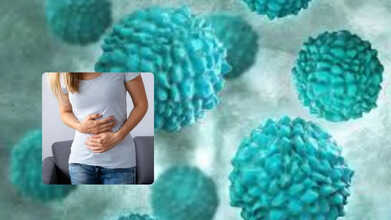- Health Conditions A-Z
- Health & Wellness
- Nutrition
- Fitness
- Health News
- Ayurveda
- Videos
- Medicine A-Z
- Parenting
World Kidney Day: After Hypertension Diagnosis, Scientist Now Lives With 5 Kidneys Post Rare Third Kidney Transplant

Imagine living with not one, not two, but five kidneys—two that are failing, two that have been transplanted but are non-functioning, and one that is a new implant sustaining you. This is the incredible reality of 47-year-old researcher Devendra Barlewar, whose relentless battle with chronic kidney disease led a groundbreaking third kidney transplant. After years of dialysis, unsuccessful surgeries, and the crippling effect of COVID-19, his survival is not only about living but a result of the extraordinary progress in modern medicine. Here's how a group of expert doctors in India made history with one of the rarest transplant cases on record.
Mr. Barlewar's story is a testament to the advances of medicine and the strength of the human spirit. Having fought chronic kidney disease (CKD) for more than 15 years, he had his third kidney transplant after two earlier failed attempts. His situation poses a special surgical challenge and immunological risk, an unprecedented accomplishment in organ transplantation.
The battle of the scientist with kidney disease was first encountered in 2008 when he was diagnosed with high blood pressure. Lacking any underlying conditions, his health rapidly worsened, and he became dependent on dialysis by 2009. In the following years, he received two kidney transplants, one in 2010 and the other in 2012, both of which failed, making him depend on dialysis again. The second kidney transplant survived for a number of years before it was sabotaged by COVID-19 in 2022, leading to total organ failure. Lacking close family members for a live donation, he enrolled for a deceased donor transplant at Amrita Hospital in 2023. His turn arrived on January 7, 2025, when a matching kidney from a brain-dead donor was made available.
Challenges of Kidney Transplant
A third renal transplant is very uncommon and has special medical complications, such as:
Immunological Risks: As he had two non-functioning native kidneys and two formerly transplanted kidneys, his immune system was extremely sensitized, which raised the risk of organ rejection. To counteract this, physicians used cutting-edge immunosuppressive techniques to hinder a reaction by the immune system against the newly transplanted organ.
Surgical Complexity: Four kidneys created a space limitation inside the abdominal cavity. The surgeons needed to tread carefully to provide space for the new kidney without compromising its blood supply.
Vascular Limitations: The blood vessels used in his previous transplants had already been utilized, making it crucial to identify and connect the new kidney to the largest available abdominal blood vessels. Extensive preoperative imaging and surgical expertise were required to navigate this challenge.
Dr. Ahmed Kamaal, Senior Urology Consultant, who was a member of the surgical team, added, "This was an unprecedented case. With four existing kidneys, there were huge immunological risks involved and the need for special protocols. We maximized the patient with immunosuppression pre-transplant to preserve his new kidney transplant from the threat of rejection."
Role of the Organ Donor
Organ donation was instrumental in making this operation feasible. The 50-year-old farmer was certified brain dead after suffering a stroke. His family decided to donate his organs out of kindness, and the kidney that was a perfect match for Mr. Barlewar was one of them. Being a long-standing member of the transplant program's registration history, he was prioritized to undergo the procedure.
The operation itself involved careful planning and execution. The surgical team utilized high-tech medical imaging, immunological testing, and microvascular equipment to achieve precision. The four-hour operation entailed:
Preoperative Planning: High-resolution CT scans were employed to establish the most appropriate position of the kidney and check viability of the blood vessels.
Immunological Preparation: Advanced laboratory testing was performed to assess antibody levels, ensuring compatibility and reducing rejection risk.
Surgical Performance: The kidney was attached to the largest blood vessels in the abdomen, with utmost care being taken to prevent any complications.
Postoperative Care: After the transplant, the patient was transferred to intensive care for careful monitoring of vital signs, kidney function, and complications like internal bleeding, infection, or graft rejection.
Dr. Kunal Gandhi, Senior Nephrology Consultant, stressed, "Two non-functioning kidneys pose severe immunological issues, especially during the initial post-operative period. They cause organ rejection if not treated. High-tech medicine and in-house immunology testing were a must to provide the optimal result."
After the successful transplant, Mr. Barlewar's new transplanted kidney started secreting urine within hours, an important sign of graft function. He spent some days in intensive care, where he was continuously monitored to ensure his body received the organ well. After ten days, he was discharged with stable kidney function and his levels of creatinine normalized within two weeks, which was a major improvement in his condition.
Dr. Sameer Bhate, Head of Cardiac Surgery and Senior Consultant, emphasized the importance of the surgical skill involved: "The anastomosis of renal vessels to the largest abdominal blood vessels is a delicate process that calls for skillful surgery."
Although Mr. Barlewar's case is medically unprecedented, it also highlights the significance of organ donation and the evolution of transplantation methods. His experience shows the strength of patients with chronic illnesses and the life-changing effects of novel medical treatments.
Now dialysis-free for the first time in years, Mr. Barlewar is independent once more and back in his routine daily activities. His case provides a precedent within the medical profession, hope for thousands of patients around the globe who are waiting for kidney transplants.
The successful third kidney transplant of Mr. Devendra Barlewar is an affirmation of the latest advances in medicine, unparalleled surgical skill, and organ donor generosity. The tale emphasizes the significance of organ donation in saving lives and the pursuit of medical perfection in addressing complicated medical problems. With ongoing developments in transplantation research, the case is an inspiration to patients and the international medical community as well.
All the doctors who were part of the surgical team are practising doctors at Amrita Hospital in India
Norovirus 2025: How Contagious Is the Stomach Bug Spreading Across the US

Credits: Canva
Norovirus, often called the stomach bug, has returned. Between August 1 and December 11, health officials recorded 268 norovirus outbreaks, with numbers climbing steadily as winter travel increases and more people spend time indoors. The virus triggers stomach-related symptoms such as nausea, vomiting, diarrhea, and abdominal pain or cramping.
Some people also develop fever, headaches, and body aches. Although case numbers are not rising as sharply as flu, doctors remain concerned because norovirus spreads extremely easily. Making matters worse, norovirus is difficult to kill. Many of the common precautions used against flu and COVID offer little protection against this so-called winter vomiting bug.
How Contagious Is the Norovirus?
Norovirus is among the most infectious viruses doctors deal with. “It can tear through a household and then circle back, with people repeatedly passing it to each other,” says Amy Edwards, MD, associate professor of pediatrics at Case Western Reserve University School of Medicine in Cleveland, Ohio, who specializes in infectious diseases. “It also spreads very quickly in crowded, closed settings like cruise ships.”
While contaminated surfaces can transmit norovirus, doctors say person-to-person spread is most common. An infected person can pass on the virus even before symptoms appear, throughout the illness, and after they start to feel better, Jennings warns.
What to Do If You Get Norovirus?
For most people, norovirus symptoms ease within a few days, according to Jennings. However, the illness can be more serious for those with weaker immune systems, including young children, older adults, and people with certain health conditions.
If you think you have norovirus, focus on staying well hydrated. Ongoing vomiting can quickly lead to fluid loss and electrolyte imbalance. To prevent nausea from getting worse, Jennings recommends taking small sips of clear fluids like water, ginger ale, or coconut water.
Most importantly, seek medical care right away if you become dehydrated or if diarrhea lasts for weeks. Fischer explains that dehydration may cause sunken eyes, less frequent urination, dry skin and mouth, and extreme tiredness.
Common Norovirus Symptoms That You Should Be Aware Of
Norovirus symptoms often come on suddenly and may include:
- Nausea
- Vomiting
- Stomach pain or cramps
- Watery or loose diarrhea
- General feeling of illness
- Mild fever
- Muscle aches
Symptoms usually begin 12 to 48 hours after exposure and last for one to three days. Even after recovery, people can continue shedding the virus in their stool for weeks. In some cases, especially among those with other medical conditions, shedding can continue for months. Some people infected with norovirus never develop symptoms at all. Even so, they can still spread the virus to others.
Norovirus Causes
Norovirus spreads very easily from one person to another. Because it is highly contagious, an infection can pass quickly through homes, schools, or other shared spaces. The virus is released through stool and vomit, and a person can spread it from the moment symptoms begin until several days after they feel better. Norovirus can also survive on surfaces and objects for days or even weeks.
You can catch norovirus by:
- Eating food that has been contaminated
- Drinking unsafe or contaminated water
- Touching your mouth after your hands have come into contact with a contaminated surface or object
- Having close contact with someone who is infected with norovirus
Norovirus is especially hard to get rid of because it can survive extreme hot and cold temperatures and is resistant to many common disinfectants.
Using Bisoprolol? NHS Advises Patients To Watch For These Side Effects

Credits: Canva
The NHS has issued fresh advice for people taking a widely prescribed medicine used to manage heart and circulation conditions. Across the UK, millions rely on beta-blockers to treat heart and blood vessel problems. Each year, more than 50 million prescriptions are written for these drugs, which help manage issues ranging from high blood pressure and abnormal heart rate to certain conditions affecting the brain and nervous system. Doctors most commonly prescribe bisoprolol, which NHS England lists as the seventh most prescribed medicine in the country.
What Is Bisoprolol Used For?
Bisoprolol, sold under brand names such as Zebeta, Bisotab, and Concor, belongs to a group of medicines called beta-blockers. It is mainly used to treat various heart-related conditions by slowing the heart rate and relaxing blood vessels. This reduces strain on the heart and helps it pump blood more efficiently, according to the CDC. The NHS also explains that bisoprolol is used to prevent chest pain caused by angina and to manage atrial fibrillation and other irregular heart rhythms. By slowing the heart, it allows the heart muscle to work more effectively.
Data from 2024–25 shows that bisoprolol was dispensed around 32 million times in England alone. The NHS notes that for people with high blood pressure, taking bisoprolol can help lower the risk of future heart disease, heart attacks, and strokes.
Bisoprolol Side Effects: Why Is NHS Warning Against Bisoprolol?
Like most medicines, bisoprolol can cause side effects, and patients are advised to stay alert to them. People starting the medication are often told to take their first dose at night, as it can make some feel dizzy. There are several common side effects that affect more than one in 100 people. According to the NHS, these are usually mild and tend to settle over time. They include:
- feeling dizzy or sick
- headaches
- cold hands or feet
- constipation
- diarrhoea
However, there are less common but more serious side effects that should not be ignored, as they may require urgent medical attention. The NHS advises contacting a doctor or calling 111 if:
- you experience shortness of breath with a cough that worsens during physical activity, swelling in the ankles or legs, or an irregular heartbeat, as these can point to heart problems
- the whites of your eyes or your skin turn yellow, which may be harder to notice on darker skin tones, as this can signal liver issues
Bisoprolol Warning: When Should You See Medical Emergency
The NHS also urges people to seek immediate help if certain symptoms appear. These include:
- chest pain, which could indicate heart trouble
- shortness of breath, wheezing, or tightness in the chest, which may suggest lung-related problems
Emergency services should be contacted straight away if there are signs of a severe allergic reaction, known as anaphylaxis. The NHS says to call 999 immediately if:
- your lips, mouth, throat, or tongue suddenly swell
- you are breathing very fast or struggling to breathe, with wheezing or a choking sensation
- your throat feels tight or you have difficulty swallowing
- your skin, lips, or tongue turn blue, grey, or pale, which may be more visible on the palms or soles in people with darker skin
- you suddenly feel very confused, extremely drowsy, or dizzy
- someone collapses and cannot be woken
- a child becomes limp, floppy, or unusually unresponsive, with difficulty holding their head up or focusing
The NHS stresses that while bisoprolol is effective and widely used, knowing when side effects are harmless and when they signal an emergency is key to staying safe.
Rabies Pre-Exposure Prophylaxis Vaccine Can Protect You Even Before A Dog Bite—Here’s How

Credits: Canva
Rabies is a fatal viral disease that spreads to humans through the saliva of infected animals. It targets the central nervous system, and nearly 99 percent of human cases are linked to infected dogs. A recent *Lancet* study found that about 5,726 people still die from rabies each year, even though overall deaths have declined over time. This is why prompt medical care after a dog bite or scratch is critical. Most people believe the rabies vaccine taken after a bite is enough. What many do not realise is that a pre-exposure prophylaxis vaccine is also available and can be taken even before a bite occurs. So why does this vaccine matter, and how does it actually protect you?
What Is A Rabies Pre Exposure Prophylaxis Vaccine?
A rabies pre-exposure prophylaxis, or PrEP, vaccine involves a set of shots given before any possible contact with the rabies virus. It is mainly recommended for people at higher risk, such as veterinarians, animal handlers, laboratory workers, and travellers visiting regions where rabies is common. While PrEP does not remove the need for treatment after a bite, it makes post-exposure care simpler. People who have received PrEP need fewer follow-up injections and do not require rabies immunoglobulin, which can be hard to access in emergencies and may save crucial time.
How Can Rabies Pre Exposure Prophylaxis Vaccine Protect You?
According to Dr Deepa Aggarwal, who shared insights on her Instagram account, the rabies pre-exposure prophylaxis vaccine prepares the immune system in advance. It helps the body develop antibodies before any exposure occurs. If a vaccinated person is bitten later, they need only two booster shots and no immunoglobulin. The immune response is quicker, lowering the risk of the virus spreading to the brain. This is especially important for people at high risk or in situations where medical treatment may be delayed.
Rabies Pre Exposure Prophylaxis Vaccine: How It Works?
- Introduces Antigens: The vaccine contains an inactivated form of the rabies virus, which safely exposes the body to its antigens.
- Builds Memory: The immune system learns to recognise these antigens and creates antibodies along with memory cells.
- Rapid Response on Exposure: If exposure happens later, these memory cells act fast, producing antibodies that stop the virus before it can cause infection.
CDC Guidelines On Rabies Pre Exposure Prophylaxis Vaccine
The Advisory Committee on Immunization Practices, or ACIP, has updated its recommendations for rabies PrEP.
- A two-dose PrEP schedule has now replaced the earlier three-dose schedule and offers protection for up to three years. Options for maintaining protection beyond three years are also outlined on their website.
- The minimum antibody level used to decide whether a booster is needed has been revised and standardised.
- Many people who previously needed antibody testing every two years now require only a one-time titer check, followed by a booster if levels are low, or in some cases, just a one-time booster.
Who Should Get The Rabies Pre Exposure Prophylaxis Vaccine?
While the vaccine can benefit anyone, rabies pre-exposure prophylaxis is mainly advised for people with frequent or high risk of exposure. This includes veterinarians, animal handlers, wildlife workers, laboratory staff, and travellers to areas where rabies is widespread. The vaccine makes treatment after a bite easier by reducing the number of shots required. However, health authorities stress that while PrEP offers protection, it does not replace full post-exposure treatment after a confirmed bite, as advised by the CDC and WHO.
© 2024 Bennett, Coleman & Company Limited

